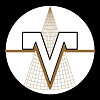Crossover Filter Types
This is a brief overview of the different crossover filter types.
Contents
Linkwitz – Riley
These are even order filters. They consist of one or more cascaded second order filter sections. Very popular are the second order LR2 and the fourth order LR4 filters.
SPL
Voltage level at the crossover frequency is – 6dB. The SPL sum is flat around the crossover point.
Phase
Low pass and high pass sections are phase aligned. For LR2 the sections have opposite phase, for the LR4 the sections are in phase. The group delay has a small boost around the crossover frequency.
Power
For frequencies where the distance between the transducer centers becomes close to the wavelength of the sound, there is a power dip at the crossover frequency.
Polar
Very characteristic for these filters is a symmetric vertical polar diagram around the on axis at the crossover frequency, if the distance between the transducer centers becomes close to the wavelength of the sound. The SPL is maximum on axis, there is no SPL boost off axis.
Butterworth
There are even and odd order Butterworth filters. Most popular are the odd order versions, as the even versions don’t have a flat SPL sum.
SPL
Voltage level at the crossover frequency is – 3dB.
For the even order versions B2, B4,… the SPL sum is not flat around the crossover point. There is a boost of + 3dB.
For the odd order versions B1, B3,… the SPL sum is flat around the crossover point.
Phase
For the even order version, low pass and high pass sections are phase aligned. For B2, the sections are in anti-phase, for the B4 the sections are in phase. The group delay has a small boost around the crossover frequency.
For the odd order version, low pass and high pass sections haves a 90 degree phase difference.
Power
For the even and odd order versions the power response is flat.
Polar
Very characteristic for the odd order Butterworth filters is an asymmetric vertical polar diagram at the crossover frequency, if the distance between the transducer centers becomes close to the wavelength of the sound. There is a +3dB off axis SPL peak below the on-axis curve.
Duelund
The Duelund filters consist of even order filter sections. The Q-factor of the sections is chosen low in a way the group delay of the sum shows no (or minor) boost, they are well damped filters. The sum of the sections has an all-pass behavior.
Duelund filters are described in more detail on the VCLLabs website Tech Page 01 – VCLLabs.
SPL
Voltage level at the crossover frequency is – 6dB, the SPL sum is flat.
Phase
For the different sections with same order, they are phase aligned.
Power
For frequencies where the distance between the transducer centers becomes close to the wavelength of the sound, there is a power dip at the crossover frequency.
Polar
For these filters the vertical polar diagram at the crossover frequency is symmetric, if the distance between the transducer centers becomes close to the wavelength of the sound.
Elliptical
Elliptical filters have the property to have a very steep slope in the outband.
VCLLabs has designed a third order EL3 and a fifth order EL5 version. They are designed for the sum response to have minimal ripple and the phase as best aligned as possible.
Using the steep slopes, the interaction between the drivers is minimal.
SPL
Voltage level at the crossover frequency is – 6dB.
For the odd order VCLLabs versions EL3 and EL5 the SPL sum has a small ripple of +/- 0.25 dB around the crossover point.
Phase
For the odd order VCLLabs versions EL3 and EL5, there is a phase difference of about 10 degrees around the crossover point.
Power
For frequencies where the distance between the transducer centers becomes close to the wavelength of the sound, there is a small power dip at the crossover frequency.
Polar
For these filters the vertical polar diagram at the crossover frequency is almost symmetric, if the distance between the transducer centers becomes close to the wavelength of the sound.
